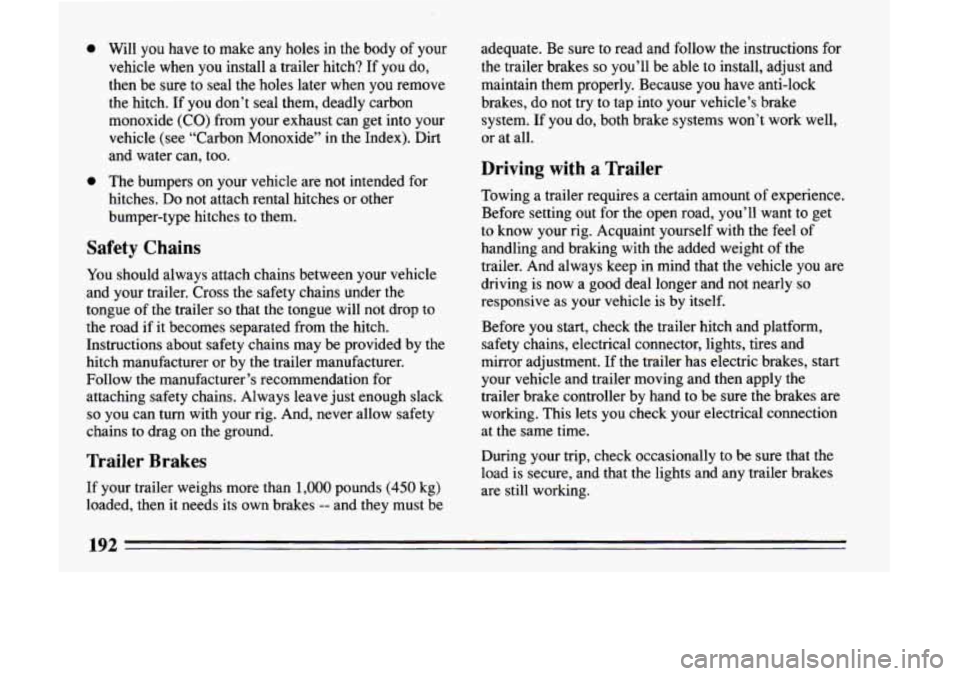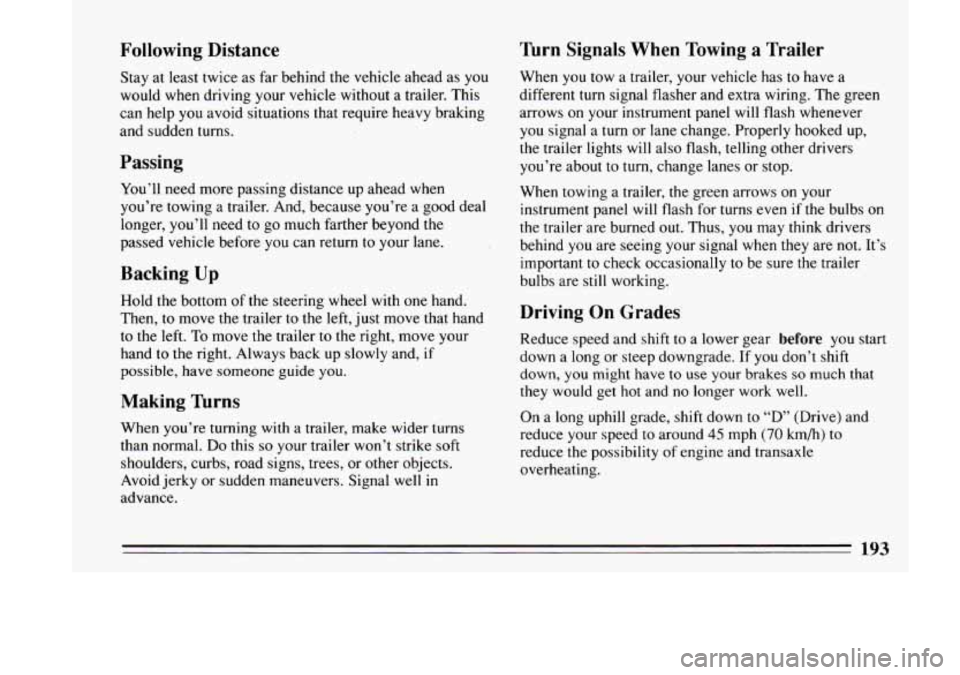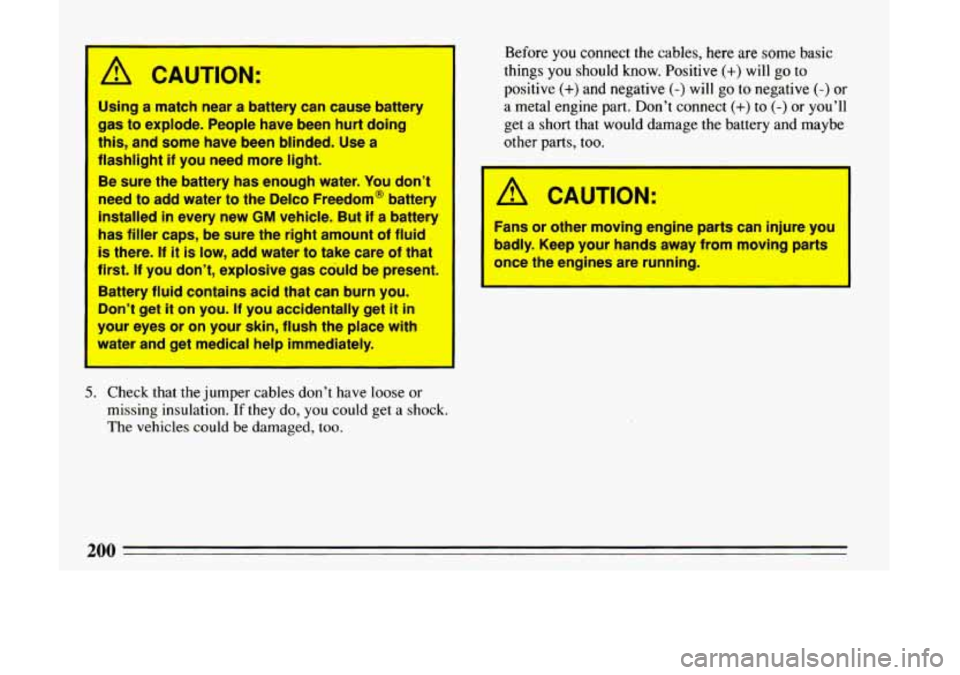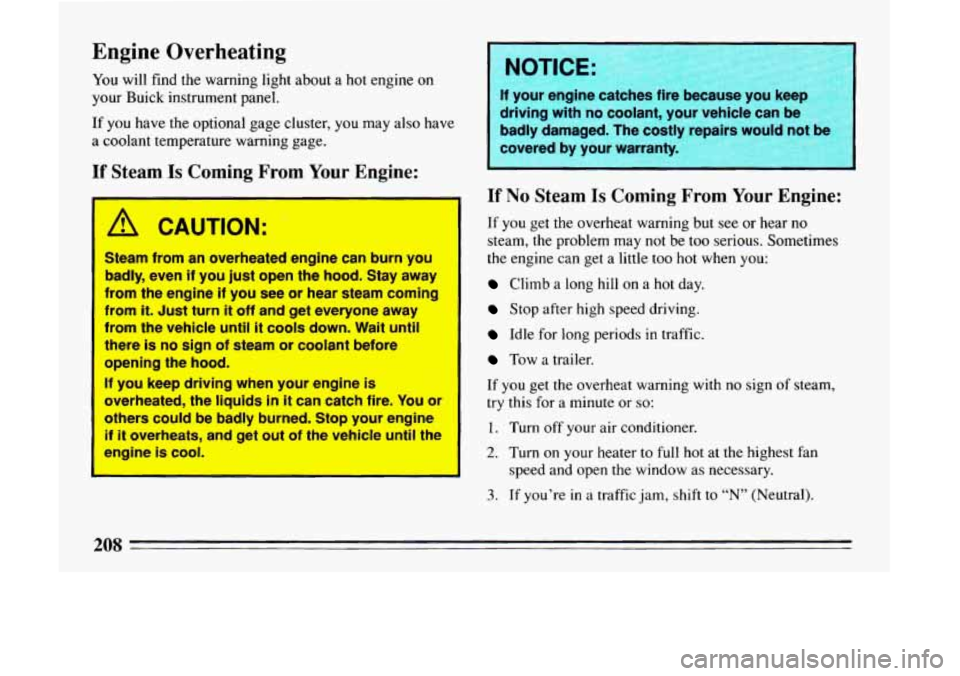Page 190 of 324

passengers safe: Turn on your hazard flashers. Tie a red
cloth to your vehicle to alert police that you’ve been
stopped
by the snow. Put on extra clothing or wrap a
blanket around you.
If you have no blankets or extra
clothing, make body insulators from newspapers, burlap
bags, rags, floor mats
-- anything you can wrap around
yourself or tuck under your clothing to keep warm.
You can run the engine to keep warm, but be careful.
CAUTION: (Continued)
-
4
I-
b, CAUTION:
Snow can trap exhaust gases under your vehicle.
Thls can cause deadly CO (carbon monoxlda)
gas to get inslde. Cb could overcome you and
kill you. You can’t see It or smell it, 50 you might
not know it is in your vehicle. Clear away pow
from around the base of your vehicle I especially
any that is blocking your exhaugt pipe. And
cbk around again from time to time to be sum
snow doesn’t collect them
Open
a window just a little on the slde of the
vehicle that’s away from the wind. This will help
keep CO out.
CAUTION: (Continued)
Run your engine only as long as you must. This saves
fuel. When you run the engine, make it go
a little faster
than just idle. That
is, push the accelerator slightly. This
uses less fuel for the heat that you get and it keeps the
battery charged.
You will need a well-charged battery to
restart the vehicle, and possibly for signaling later on
with your headlights. Let the heater run for awhile.
Then, shut the engine off and close the window almost
all the way to preserve the heat. Start the engine again
and repeat this only when you feel really uncomfortable
188
Page 194 of 324

e e Will you have to make any holes in the body of your vehicle when you install a trailer hitch? If you
do,
then be sure to seal the holes later when you remove
the hitch. If you don’t seal them, deadly carbon
monoxide
(CO) from your exhaust can get into your
vehicle (see “Carbon Monoxide” in the Index). Dirt
and water can, too.
The bumpers on your vehicle are not intended for
hitches.
Do not attach rental hitches or other
bumper-type hitches to them. adequate.
Be sure to read and follow the instructions for
the trailer brakes
so you’ll be able to install, adjust and
maintain them properly. Because you have anti-lock
brakes, do not try to tap into your vehicle’s brake
system.
If you do, both brake systems won’t work well,
or at all.
Driving with a Trailer
Towing a trailer requires a certain amount of experience.
Before setting out for the open road, you’ll want to get
to know your rig. Acquaint yourself with the feel of
handling and braking with the added weight of the
trailer. And always keep in mind that the vehicle you are
driving is now a good deal longer and not nearly
so
responsive as your vehicle is by itself.
Safety Chains
You should always attach chains between your vehicle
and your trailer.
Cross the safety chains under the
tongue
of the trailer so that the tongue will not drop to
the road if it becomes separated from the hitch.
Instructions about safety chains may be provided by the
hitch manufacturer or by the trailer manufacturer.
Follow the manufacturer’s recommendation for
attaching safety chains. Always leave just enough slack
so you can turn with your rig. And, never allow safety
chains to drag
on the ground.
Trailer Brakes
If your trailer weighs more than 1,000 pounds (450 kg)
loaded, then it needs its own brakes
-- and they must be
192
~-
Before you start, check the trailer hitch and platform,
safety chains, electrical connector, lights, tires
and
mirror adjustment. If the trailer has electric brakes, start
your vehicle and trailer moving and then apply the
trailer brake controller by hand to be sure the brakes are
working. This lets you check your electrical connection
at the same time.
During your trip, check occasionally
to be sure that the
load is secure, and that the lights and any trailer brakes
are still working.
Page 195 of 324

Following Distance
Stay at least twice as far behind the vehicle ahead as you
would when driving your vehicle without a trailer. This
can help
you avoid situations that require heavy braking
and sudden turns.
Passing
You’ll need more passing distance up ahead when
you’re towing a trailer. And, because you’re a good deal
longer, you’ll need to go much farther beyond the
passed vehicle before you can return
to your lane.
Backing Up
Hold the bottom of the steering wheel with one hand.
Then,
to move the trailer to the left, just move that hand
to the left. To move the trailer to the right, move your
hand
to the right. Always back up slowly and, if
possible, have someone guide you.
Making nrns
When you’re turning with a trailer, make wider turns
than normal. Do this
so your trailer won’t strike soft
shoulders, curbs, road signs, trees, or other objects.
Avoid jerky or sudden maneuvers. Signal well
in
advance.
Turn Signals When Towing a Trailer
When you tow a trailer, your vehicle has to have a
different turn signal flasher and extra wiring. The green
arrows
on your instrument panel will flash whenever
you signal a turn
or lane change. Properly hooked up,
the trailer lights will also flash, telling other drivers
you’re about to turn, change lanes or stop.
When towing a trailer, the green arrows on your
instrument panel will flash for turns even if the bulbs on
the trailer are burned out.
Thus, you may think drivers
behind you are seeing your signal when they are
not. It’s
important to check occasionally to be sure the trailer
bulbs are still working.
Driving On Grades
Reduce speed and shift to a lower gear before you start
down a long or steep downgrade. If you don’t shift
down,
you might have to use your brakes so much that
they would get hot and no longer work well.
On a long uphill grade, shift down to “D” (Drive) and
reduce your speed to around
45 mph (70 km/h) to
reduce the possibility of engine and transaxle
overheating.
193
Page 198 of 324
Hazard Warning Flashers
I
I
.-
Your hazard warning flashers let you warn others. They
also
let police know you have a problem. Your front and
rear turn signal lights will flash on
and off.
196
Page 199 of 324
Press the button in to make your front and rear turn
signal lights flash on and
off.
Your hazard warning flashers work no matter what
position your key
is in, and even if the key isn't in.
To turn off the flashers, pull out on the collar. When the
hazard warning flashers are on, your turn signals won't
work.
Other Warning Devices
If you carry reflective triangles, you can set one up at
the side
of the road about 300 feet (1 00 m) behind your
vehicle.
197
Page 201 of 324
’
A CAUTION:
You could be injured if the vehicles roll. Set the
parking brake firmly on each vehicle. Put an
automatic transaxle in
“P” (Park) or a manual
transaxle
in “N” (Neutral).
3. Turn off the ignition on both vehicles. Turn off all
lights that aren’t needed, and radios. This will avoid
sparks and help save both batteries. And
it could
save
your radio!
If you leave your radio on, It could be my
damaged. The repairs wouldn’t be covered by
your warranty.
1
4. Open the hoods and locate the batteries.
‘
A CAUTION:
An electric fan can start up even when the engine
is not running and can injure you. Keep hands,
clothing
and tools away from any underhood
electric fan.
I
Find the positive (+) and negative (-) terminals on each
battery.
Page 202 of 324

A CAUTION:
Using a match near a battery can cause battery
gas to explode. People have been hurt doing
this, and some have been blinded. Use a
flashlight
if you need more light.
Be sure the battery has enough water.
You don’t
need to add water to the Delco Freedom@ battery
installed in every new GM vehicle. But if a battery
has filler caps, be sure the right amount of fluid
is there. If it is low, add water to take care of that
first. If you don’t, explosive gas cduld be present.
Battery fluid contains acid that can burn you.
Don’t get it on you. If you accidentally get it in
your
eyes or on your skin, flush the place with
water and
get medical help immediately.
5. Check that the jumper cables don’t have loose or
missing insulation. If they do, you could get a shock.
The vehicles could
be damaged, too. Before
you connect the cables, here
are some basic
things
you should know. Positive (+) will go to
positive
(+) and negative (-) will go to negative (-) or
a metal engine part. Don’t connect
(+) to (-) or you’ll
get a short that would damage
the battery and maybe
other parts, too.
A CAUTION:
. ms or other moving engine parts can injure you
badly.
Keep your hands away from moving parts
once the engines
are running. I I I
200
Page 210 of 324

Engine Overheating
You will find the warning light about a hot engine on
your Buick instrument panel,
If you have the optional gage cluster, you may also have
a coolant temperature warning gage.
If Steam Is Coming From Your Engine:
CAUTION:
eam from an overheated engine can burn you
badly, even if you just open
the hood. Stay away
from
the engine if you see or hear steam coming
from
it. Just turn it off and get everyone away
From the vehicle until
it cools down. Wait until
there
is no sign of steam or coolant before
opening the hood.
If you keep driving when your engine is
overheated, the liquids in it can catch fire. You or
others could be badly burned. Stop your engine
if it overheats, and get out of the vehicle until the
engine is cool. badly
damaged. The costly
covered by your warranty.
If No Steam Is Coming From Your Engine:
If you get the overheat warning but see or hear no
steam, the problem may not be too serious. Sometimes
the engine can get a little too
hot when you:
Climb a long hill on a hot day.
Stop after high speed driving.
Idle for long periods in traffic.
Tow a trailer.
If you get the overheat warning with no sign of steam,
try this for a minute or so:
1. Turn off your air conditioner.
2. Turn on your heater to full hot at the highest fan
speed and open the window as necessary.
3. If you’re in a traffic jam, shift to “N” (Neutral).
208